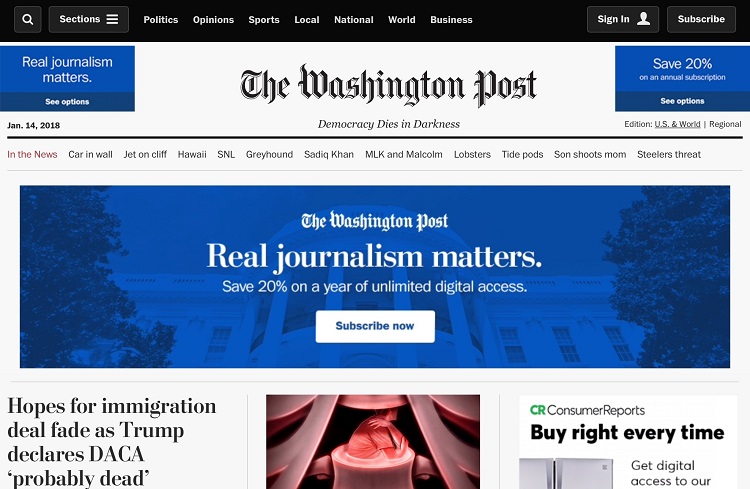In October, 2013, Jeff Bezos bought the Washington Post. I could have written “struggling Washington Post”, but that’s kind of redundant for most newspapers these days.
Now WaPo has reported a profit for the past two years.
When most companies acquire newspapers these days they cut, cut, cut. Bezos did just the opposite. Initially he invested tens of millions of dollars into the newspaper, hiring and using data to improve their digital experience. That was just the beginning.
Within a few years its Web traffic had doubled, subscriptions were way up and their smaller staff was posting far more online content than the New York Times and even BuzzFeed. Licensing their new, speedy content management system to other newspapers may be an auxiliary line of revenue, like Amazon Web Services (AWS) is for Amazon.
A strong conversion experience for non-subscribers on the website is also important in increasing paid subscriptions, as I recommend for Phase 1 of my Bullseye Marketing Framework.
 A Columbia Journalism Review interview with CIO Shailesh Prakash and Director of Product Joey Marburger offers many more insights into how the company changed.
A Columbia Journalism Review interview with CIO Shailesh Prakash and Director of Product Joey Marburger offers many more insights into how the company changed.
Technology: It’s been proven over and over again that speed matters. In some industries, the correlation is more direct, like in retail. You have a site and you change nothing except it becomes much faster, you see the sales change.
If you’re used to a lot of other slow mobile sites out there, specifically news, and you come to us and it’s significantly faster, you may be more likely to come to us on a regular basis. And you’re more likely—which we see already in the data—to consume more content, hit the subscription meter faster, consume more ads, you name it.
User Experience: It was Bezos who brought this up. He said that when Amazon made the Kindle, they didn’t think, ‘Let’s get rid of the book and come up with a new way to read books.’ Their whole approach was, ‘How can we keep everything that’s fantastic about a book and also add in the gifts of digital?’
Culture: It’s been three years since Jeff bought us. I’d say we’d probably be where we are maybe five to seven years from now. And who knows if we would’ve done half of what we’ve gotten done. But Jeff didn’t just reach down to the newsroom and say here’s a brand-new culture, here’s a bunch of things you should do, here’s what Amazon does, so you should copy it. The sheer thought of him spread throughout the company. Over night, we thought there wasn’t much we couldn’t do
Compensation: The number one criteria that grows our compensation used to be operating income. Did you or did you not hit the operating income target that was agreed upon at the beginning of the year? It was crystal clear whether you got your bonus or not. We were all in it together. When revenue was slowing and operating income is the target, then what do you do? You cut costs. There’s no other way out.
When Jeff bought us, within about six months, he threw that out. Now there are three other criteria. It’s basically: How fast do you move? It’s very subjective. The second one is that there are no sacred cows, to push experimentation. The third thing is debate, but commit. So you can argue all you want, but once we agree, then there’s no undermining. Those are the three things that now very subjectively drive the compensation.
Market focus: We had for a very long time a tag line that said ‘For and About Washington.’ One of the big changes and explicit changes in strategy has been to go after a national and international audience. One of the things we’ve tried to do is to look at platforms we might be able to over-index on to get there faster. Take Facebook. One in seven humans visits Facebook every day. It’s not possible to grow nationally and internationally if you say, ‘I will send them 10 articles.’ If we want to grow nationally and internationally it is really not an option to just ignore that platform.
Very interesting. Check it out.
And if you’re interested in this topic, The New York Times’ “Innovation” study is available to download from our website.
